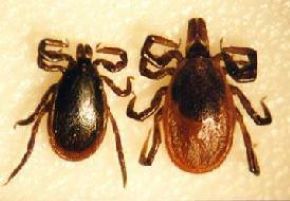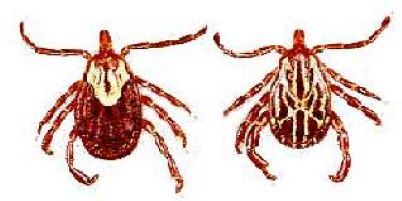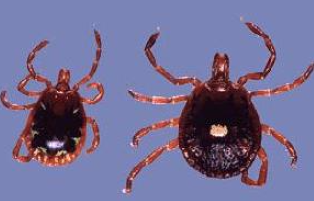|
The Sunshine State, while famous for its pristine sands, thrilling theme parks, and crystal clear blue springs, its tropical climate creates a brilliant breeding ground for a variety of creepy crawlies to thrive. With the increase in the frequency of tick-borne illnesses in recent years and peak-tick season right around the corner, it's crucial to be in the know on which species of ticks in Florida exist and where they live — as well the risks that they pose to your health. Ticks in Florida will go through four lifecycle stages: egg, larva, nymph, and adult. After they've hatched, larvae typically will have three legs and immediately begin their search for a host for their first blood feast. Once fed they'll molt, entering into the nymph stage, where they'll grow a 4th leg and continue their search for blood. After getting their fill in the nymph stage, they'll molt again, progressing into being an adult. They'll need to feed in this stage to be able to lay eggs and start the cycle anew. A tick's entire lifecycle can take anywhere from a few months to a couple of years, all depending on the species and its environmental conditions. Ticks carry a host of different diseases, with the most commonly transmitted diseases in Florida being Lyme Disease, Ehrlichiosis, Rocky Mountain Spotted Fever, and other spotted fever illnesses. While not all ticks carry pathogens, the Florida Lyme Disease Association says that number is on the rise. "Most people are infected by nymphal stages during the spring and summer," said the Florida Department of Health, "Nymphs are often small enough to escape notice and so can stay attached longer than adults, increasing risk of disease transmission." So what ticks do you have to look out for in Florida? Which diseases do we have to contend with? There are a few different species in the Sunshine State, most seeing their peak populations sitting between March and July — each capable of carrying unique sets of diseases and infections. With Spring Break having already come and gone and summer travel right around the corner, let's take a deeper look at the 6 species of tick found in Florida, where they thrive, the diseases they can cause, how you can remove them if you've been bit, and what you can do to prevent finding one feeding on you while you're Uncovering Florida. 1. American Dog Tick These ticks are generally more prevalent in the Eastern US, Midwest, and Northwest, preferring open grassy field lands. When in their larval and nymph stages, they almost exclusively prefer small rodents as their feeding host, particularly mice, and cotton rats. It's when this species becomes a full-grown adult that they start to crave Karen's coveted O-Negative and the blood of other large mammals. In Florida, larval dog ticks are most common from July to February, with nymphs being at their most abundant between January and March. Adults will want their bite of you during their peak abundance from March to September. They're known to carry two diseases specifically, Tularemia, also known as "Rabbit Fever", and Rocky Mountain Spotted Fever (RMSF) — a bacterial disease that causes fever, headache, and a body rash. If not treated early with the right antibiotic, the CDC says RMSF can be deadly. The American Dog Tick is also one of the top 3 ticks you're most likely to get bitten by. 2. Argasid Tick Also known as the soft tick, these are more commonly found in the western half of the US and Texas, though can be found in Florida as well. Humans are most likely to come into contact with this variation of tick in rustic cabins and other poor-quality human dwellings, animal shelters, caves, and burrows. They don't experience a typical peak like other ticks and their lifecycles but can lay eggs several times during their lifespan compared to other species. They also may go through more than one nymphal molt before they reach their adult stage. Illnesses you're most likely to contract from an Argasid Tick include Ehrlichiosis, Anaplasmosis (most commonly transmitted by Black-Legged Ticks), Borrelia Hermsii and B. Turicatae bacteria that cause Tick-Borne Relapsing Fever, and STARI. 3. Black-Legged Tick You're most likely to find yourself with Lyme Disease if you've been bitten by a Black-Legged Tick. However, the Black-Legged species can also carry Babesiosis, a microscopic parasite that infects red blood cells, a form of relapsing fever called B. Miyamotoi Disease, Anaplasmosis, Ehrlichiosis, and Powassan Virus Disease. Powassan Virus Disease can cause severe brain infection and spinal cord, resulting in meningitis, feelings of confusion, coordination skill loss, speaking difficulties, and seizures. According to the CDC, approximately 1 out of every 10 people who contract this disease will die. Most widely distributed across the eastern US, they reach their most transmittable nymphal stage peak between April and August, found in woodsy areas with thick grass and brush. Thankfully, larval and nymph-stage ticks of this species prefer reptiles, specifically skinks and snakes, birds, and rodents more than they do humans. A bite is still possible in all feeding stages for Black-legged ticks though, with them being more likely to bite humans, cattle, and other large animals in the adult stage before reproduction. Adults see their peak season between September and May in the Sunshine State. Black-Legged Ticks join the American Dog Tick on the most likely to bite a human list. 4. Bont Tick This tick isn't native to Florida, though the Health Department warns it could be easily brought in from the Caribbean and other oceanic regions that the species calls home, especially with all the cruises that sail in and out of Sunshine State ports to the island chain. They recommend watching out for the Bont Tick's distinct orange and black tiger-striped coloration, with an almost lavender-ish pearling along the black of its bug booty. The concern comes with the associated diseases of this species, which include African Tick-Bite Fever, frequently fatal Heartwater in ruminants, and a skin infection caused by a fungus called Dermatophilosis. If they were to show up in Florida, they're most likely to hole up in Florida's humid forests. 5. Gulf Coast Tick Gulf Coast Ticks are scattered mostly across the southeastern US, with concentrated populations in pockets of the southeast, midwest, and northeast. They prefer to primarily feed on birds and small rodents in their nymph stages but are more likely to transmit Rocky Mountain Spotted Fever in their human-hungry adult phase. While it most commonly presents in the form of a headache, fever, and rash, it can sometimes include the appearance of a skin lesion at the site of the tick bite, though it's not common in cases of RMSF. 6. Lone Star Tick Rounding out the top 3 most likely to bite a human and final point on our list is the Lone Star Tick. Most common in the southern states and found widely across the eastern US, the females are easily distinguished by the large white dot, or "lone star", on their back. Your greatest risk of a bite from this species comes in the early spring through late fall, as they're known to be aggressive and bite humans during all stages. The adult phase sees the most attachments, with Florida's Lone Star Tick season peaking at the height of the summer in July. They're known to carry Ehrlichiosis, Anaplasmosis, and STARI, similar to their Soft Tick cousin, though they refuse to feed on rodents, preferring small mammals, birds, deer, cattle, and humans. So, how does one safely remove a tick? What about preventing them from being able to latch altogether? Here are a few tips & tricks provided by the Florida Lyme Disease Association:
0 Comments
Your comment will be posted after it is approved.
Leave a Reply. |
CATEGORIES |
|
|
Vertical Divider
|
Can't get enough?Uncover more of Florida through our channels below!
|
© COPYRIGHT 2015. ALL RIGHTS RESERVED.








 RSS Feed
RSS Feed